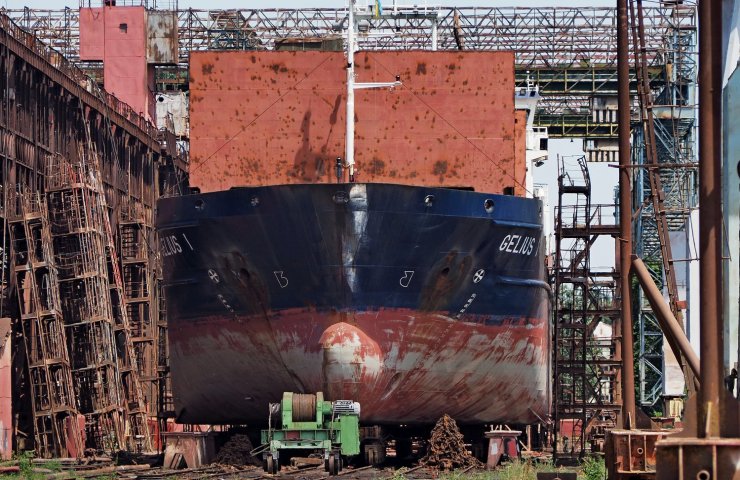Geopolitical and economic peculiarities, inland waterways (GDP) of Ukraine have enormous potential for further development. The main directions of Ukrainian GDP cargo (with subsequent delivery by sea by ships of mixed navigation or transshipment to sea vessels) are: countries of the Danube region, where it goes: coal, ferrous metal (including scrap), grain, cake, oil, mineral fertilizers, ores, coke , oil products; Turkey, where it is supplied: timber, scrap metal, grain, ore, coal, mineral fertilizers; countries of the Mediterranean basin: grain, vegetable oils.
Svetlana Shott, Marketing Director of Smart-Maritime Group, told the Shipping magazine about the prospects for the development of the Ukrainian fleet. - At present, of the inland waterways (GDP) of Ukraine, only the Dnieper (with restrictions) remains navigable. In 2019, almost 11.8 million tons of cargo were transported along the Dnieper, which is 19% more than in the previous year. During the reporting period, the volume of grain transported increased by more than 54% - up to 4.9 million tons. By the end of January-March 2020, freight traffic along the Dnieper reached 1.1 million tons. The rivers Southern Bug and Danube are being developed, where there is a problem of shallow water.
At present, the river transport of Ukraine transports less than 1% of the country's freight traffic, railway - 21%, road - 78%. For comparison, 53% of GDP is transported in the USA and India, 43% in the Netherlands, and 31% in Brazil. According to various sources, the potential cargo base in the Dnieper region alone is approximately 70 million tons and up to 350 thousand TEU. But, in addition to the availability of a cargo base, in the calculations and forecasting of the prospects for the growth of the fleet, it is necessary to take into account the infrastructure for reorienting cargo flows from "wheels" to "water".
Thus, the development of the Ukrainian fleet of river and mixed "river-sea" navigation is becoming a priority task.
It will be practically impossible to implement the European vector of development of the cargo fleet without updating on a new technical base. Even taking into account the replenishment of the fleet in recent years, the average age of transport vessels under the supervision of the Shipping Register of Ukraine is on average 35 years.
The main players in the Ukrainian market for the carriage of goods on rivers are currently ASK Ukrrichflot, IC ARGO, Grain Transhipment, JV NIBULON, Asket Shipping, AgroVista, Yenira, with Only JV NIBULON is a complex operator - it transports its goods by its own fleet, has its own terminals, as well as shipbuilding facilities. The rest of the companies have only their own fleet and terminals.
According to the State Statistics Service, the ship repair market in Ukraine in 2010-18. showed stable growth, except for an understandable "drawdown" in 2014. At the same time, 2019 as a whole repeated the results of the previous one, with a slight decrease. Moreover, for 2020, many experts and analysts predicted further growth.
The main drivers of the dynamics of the ship repair and modernization market over the past 10 years:
- obsolescence of the fleet - a 5-fold decrease in the volume of new-built vessels compared to a decade ago;
- the economic situation in the world forces shipowners to save money and try to extend the life of the existing fleet.
At the same time, in 2020, due to the coronavirus pandemic, which only intensified negative trends in commodity markets, the situation for the industry has deteriorated significantly. Additional negative factors were:
- Reduction of income for shipowners of available ship sizes for the following reasons:
- transfer of grain exports from Russia to the deep-water ports of Novorossiysk;
- a decline in the metal products market and a decrease in freight traffic;
- reduced consumption of petroleum products as a result of the coronavirus pandemic;
- shortage of liquidity among shipowners due to reduced income and limited bank lending;
- stoppages and temporary decommissioning, first of all, of old vessels with high operating costs;
- granting a deferral to shipowners for compulsory surveys for the period of quarantine, some shipowners have extended their certificates and postponed the dates of scheduled repairs to the second half of 2020.
- Most of these factors are temporary, and we expect a recovery in demand for repairs in late 2020 - early 2021.
- The entry into force of new environmental requirements opens up opportunities for the eco-modernization of ships, in particular, the installation of ballast water treatment systems.
- According to the State Statistics Service, the volume of products sold in the category of "ship repair and maintenance" in Ukraine in January-July 2020 decreased by 35% - to UAH 584.3 million.
- A significant drop in volumes forced shipbuilding enterprises to reduce the marginal profitability of repairs while fixing the current exchange rate of the hryvnia and providing up to





